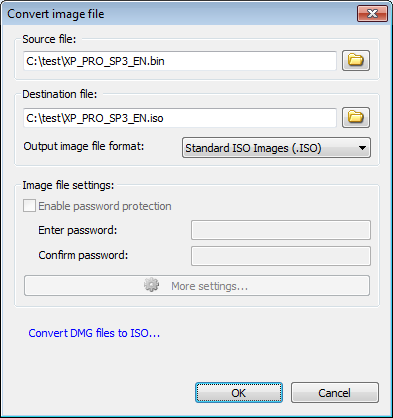
| Name | ISO |
| Full name | ISO, Disc Image File |
| File extension | .iso |
| MIME type | |
| Developed by | Unknown |
| Type of format | Misc |
| Description | ISO is the most common disc image format for both CD and DVD. The content of the ISO is an exact copy of the content of the original DVD or CD the disc image was created from. ISO files are used to create exact copies of CDs, DVDs or other media saved on discs like a CD-ROM. These copies can function as backup CDs since they do not differ from the originals when it comes to content. Much more information is saved this way than simply copying files from one disc to another where important information like the disc header information can get lost. |
| Technical details | The ISO standard the ISO files are based in is the ISO-9660 standard. In addition to the duplicated data from a physical disk, ISO files contain all necessary filesystem information from the original medium as well. This includes the discs' directory structure, the boot code and any attributes attached to the files. |
| Associated programs | 7-Zip (Windows), Alcohol 120% (Windows), Apple Disk Utility (Mac), Brasero (Linux), Canonical Furius ISO Mount (Linux), Corel WinZip (Windows), dd (Linux), DT Soft DAEMON Tools (Windows), ISO Master (Windows & Linux), K3b (Linux), LSoft Technologies Active@ ISO Burner (Windows), MagicISO MagicDist (Windows), NeoSmart Technologies EasyBCD (Windows), Nero (Windows), Parallels Desktop (Mac), PowerIso (Windows), RARLAB RAR (Android), Roxio Creator NXT Pro (Windows), Roxio Toast (Mac), SlySoft Virtual CloneDrive (Windows), VideoLAN VLC media player (Windows, Mac & Linux), VMware Fusion (Mac), WinRAR (Windows) |
| Wiki | https://en.wikipedia.org/wiki/ISO_image |


Choose 'Tools Convert' Menu. PowerISO shows Image File to ISO Converter dialog. Choose the source image file you want to convert. Set the output file format to iso file. Choose the output iso file name. Click 'OK' button to start converting. Related Topics: Convert BIN to ISO Convert DMG to ISO Convert Image File to ISO from Command Line.
How To Create An Iso File

File To Iso Converter Free Download
- 'PS3 ISO TOOLS' is an all-in-one tool for ODE- and CFW-users and features: - ISO-Generator to convert PS3-Folder-Format-Game(s) 2 PS3-ISO-Format-Game(s) (splitted big-files automatically will be joined) - ISO-Extractor to convert PS3-ISO-Format-Game(s) 2 PS3-Folder-Format-Game(s) (big-files will be optionaly splitted).
- To convert ISO to CSO, it offers a ROM Device section. Through this section, you can also convert CD to ISO, DVD to Video, etc. Another good thing about this software is its ability to perform batch conversions. Now, follow the below steps to convert ISO to CSO using this converter. How to convert ISO to CSO using FormatFactory.